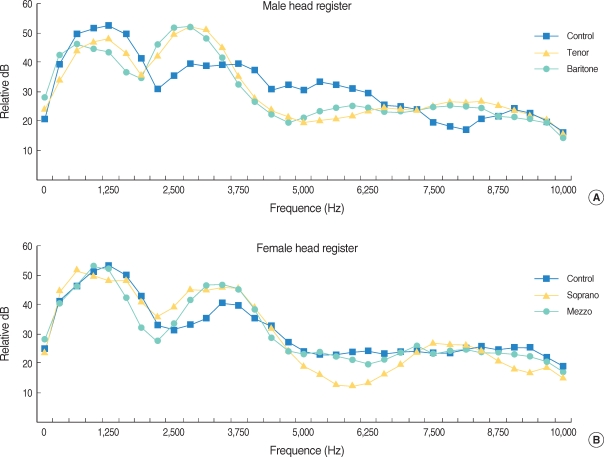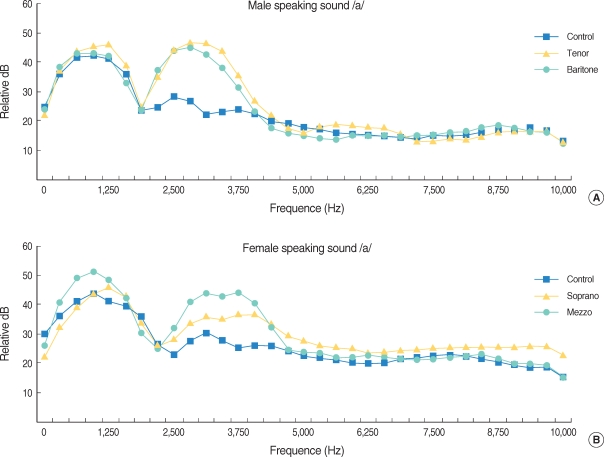Clin Exp Otorhinolaryngol.
2008 Jun;1(2):92-96. 10.3342/ceo.2008.1.2.92.
The Singer's Formant and Speaker's Ring Resonance: A Long-Term Average Spectrum Analysis
- Affiliations
-
- 1Department of Otorhinolaryngology-Head & Neck Surgery, Kangbuk Samsung Hospital, Sungkyunkwan University School of Medicine, Seoul, Korea. strobojin@hanmail.net
- KMID: 1486060
- DOI: http://doi.org/10.3342/ceo.2008.1.2.92
Abstract
OBJECTIVES
We previously showed that a trained tenor's voice has the conventional singer's formant at the region of 3 kHz and another energy peak at 8-9 kHz. Singers in other operatic voice ranges are assumed to have the same peak in their singing and speaking voice. However, to date, no specific measurement of this has been made. METHODS: Tenors, baritones, sopranos and mezzo sopranos were chosen to participate in this study of the singer's formant and the speaker's ring resonance. Untrained males (n=15) and females (n=15) were included in the control group. Each subject was asked to produce successive /a/ vowel sounds in their singing and speaking voice. For singing, the low pitch was produced in the chest register and the high notes in the head register. We collected the data on the long-term average spectra of the speaking and singing voices of the trained singers and the control groups. RESULTS: For the sounds produced from the head register, a significant energy concentration was seen in both 2.2-3.4 kHz and 7.5-8.4 kHz regions (except for the voices of the mezzo sopranos) in the trained singer group when compared to the control groups. Also, the chest register had a significant energy concentration in the 4 trained singer groups at the 2.2-3.1 kHz and 7.8-8.4 kHz. For speaking sound, all trained singers had a significant energy concentration at 2.2-5.3 kHz and sopranos had another energy concentration at 9-10 kHz. CONCLUSION: The results of this study suggest that opera singers have more energy concentration in the singer's formant/speaker's ring region, in both singing and speaking voices. Furthermore, another region of energy concentration was identified in opera singer's singing sound and in sopranos' speaking sound at 8-9 kHz. The authors believe that these energy concentrations may contribute to the rich voice of trained singers.
Keyword
Figure
Cited by 1 articles
-
Comparative Analysis of Efficiency of Injection Laryngoplasty Technique for with or without Neck Treatment Patients: A Transcartilaginous Approach Versus the Cricothyroid Approach
Seung Won Lee, Jae Wook Kim, Yoon Woo Koh, Sung Shine Shim, Young Ik Son
Clin Exp Otorhinolaryngol. 2010;3(1):37-41. doi: 10.3342/ceo.2010.3.1.37.
Reference
-
1. Bartholomew WT. A physical definition of 'good voice-quality' in the male voice. J Acoust Soc Am. 1934; 6:25–33.
Article2. Sundberg J. Staloff RT, editor. Vocal tract resonance. Professional Voice: The Science and Art of Clinical Care. 1997. 2nd ed. San Diego: Singular Publishing Group, Inc;p. 167–184.3. Sundberg J. Articulatory interpretation of the "singing formant". J Acoust Soc Am. 1974; 4. 55(4):838–844. PMID: 4833080.
Article4. Sundberg J. What's so special about singers? J Voice. 1990; 6. 4(2):107–119.
Article5. Oliveira Barrichelo VM, Heuer RJ, Dean CM, Sataloff RT. Comparison of singer's formant, speaker's ring, and LTA spectrum among classical singers and untrained normal speakers. J Voice. 2001; 9. 15(3):344–350. PMID: 11575631.6. Titze IR, Jin SM. Is there evidence of a second singer's formant? J Singing. 2003; 59(4):329–331.7. Stone RE Jr, Cleveland TF, Sundberg J. Formant frequencies in country singers' speech and singing. J Voice. 1999; 6. 13(2):161–167. PMID: 10442747.8. Lundy DS, Roy S, Casiano RR, Xue JW, Evans J. Acoustic analysis of the singing and speaking voice in singing students. J Voice. 2000; 12. 14(4):490–493. PMID: 11130107.
Article9. Sundberg J. Level and center frequency of the singer's formant. J Voice. 2001; 6. 15(2):176–186. PMID: 11411472.
Article
- Full Text Links
- Actions
-
Cited
- CITED
-
- Close
- Share
- Similar articles
-
- The Characteristics of Musical Formant and Vocal Fold Vibration in the Classical and Western-Style Singers
- Analysis of Changes in Nasal Formant, Spectra and Resonant Volume in Rhinosinus after Endoscopic Sinus Surgery
- A Case of Ring Chromosome 20 with Mental Retardation and Epilepsy
- PubMed inclusion: Clinical and Experimental Emergency Medicine joins the club
- Guidance to the Praat, a Software for Speech and Acoustic Analysis




